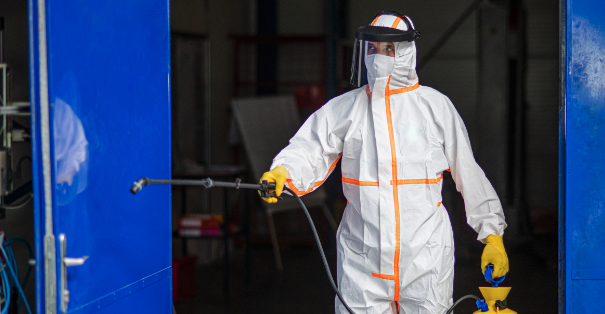SafeDE News
Smarter workplaces are safer workplaces. SafeDE is your resource for OSHA news, regulation changes, recalls, and everything to keep your business safe.
Preventing Arc Flash Injuries: Safety Tips & Prevention
Working with electricity isn’t something to fear, but it can come with risks. One of the most significant examples for employees who use electrical equipment is an arc flash injury or arc flash incident. These often occur due to human error, but they can also be a product of natural circumstances. No matter what causes an arc flash, the results are often devastating: severe burns, lung damage, and even vision or hearing loss can quickly arise.
It goes without saying, then, that you should do all you can to protect yourself and your workers from arc flash injuries. While arc flashes are relatively rare, they’re worth taking seriously. Staying aware of these and other types of electrical injuries will help you create a safer workplace for all.
Arc Flash Injuries: Prevention and Safety Tips
Reduce your risk of encountering an arc flash accident or injury with these essential prevention and safety pointers.
1. Train All On-Site Workers
Make sure that all workers who handle electrical equipment go through comprehensive electrical safety training. Include arc flash education and prevention tips in your training materials. Foster open discussions about safety on the job and encourage workers to come to you with any questions or concerns.
2. De-Energize Electrical Equipment
Power off electrical equipment that’s not in use to limit unnecessary risks. Train all employees to do the same when appropriate.
3. Carry Out Regular Risk Assessments
Investigate your workplace’s electrical equipment regularly for any signs of wear and tear. Likewise, keep up with all maintenance needs and be sure that your equipment is properly inspected for use.
4. Wear Personal Protective Equipment (PPE)
Require all workers to wear PPE on the job, and do the same for yourself. Anyone who goes near equipment should have materials like gloves, safety goggles, etc., to keep themselves safe. Enforcing PPE regulations is important, too; make sure your workers practice what you preach.
5. Maintain a Safe Distance
When possible, keep workers and other workstations away from electrical equipment. Create safe barriers between different areas to ensure that no one outside of those working on the equipment can be injured by it.
Frequently Asked Questions (FAQs)
What is an arc flash injury?
An arc flash injury occurs when interference with electrical equipment sets off an arc flash, releasing a huge amount of energy, heat, and light. These factors can easily burn skin and ignite clothing. But arc flashes are, to some extent, inevitable; even a simple mistake when working with electricity can cause electric arcing.
What are the causes of arc flash incidents?
Arc flash incidents usually occur because of short circuits, equipment failure, a fault in electrical systems, or improper electrical safety procedures. It’s also common for an arc flash to occur during electrical maintenance or installation work.
What are the symptoms of arc flash burns?
The most common symptoms of arc flash injuries are severe burns, some of which may be third-degree. Singeing of hair, damage to the eyes and ears, and injuries caused by the blast itself are also possible.
How can arc flash injuries be prevented?
The best way to prevent arc flash injuries is with proper education and safety procedures. Make sure all workers use personal protective equipment and understand the risks associated with electrical work. Also, keep all electrical equipment maintenance up-to-date.
What safety measures should be taken when working with electrical equipment?
Basic safety measures like wearing personal protective equipment are key when working with electricity. It’s also important to consider any safety protocols your workplace has established. If you’re a leader, take time to train workers on how to safely use electrical equipment and what to do in case of an emergency.
What should you do if an arc flash accident occurs?
If an arch flash accident occurs near you, the first thing you should do is de-energize (shut off) the electrical equipment if you can safely do so. Then, call emergency services and immediately notify management about the situation. Don’t interact with any equipment unless you’re sure it’s safe to do so. Feel free to evacuate the area if necessary to protect yourself and others.
What are the long-term effects of arc flash injuries?
Depending on the severity of the initial injury, long-term effects of an arc flash accident can include:
- Scarring
- Trauma and psychological changes like anxiety or depression
- Vision or hearing loss
- Limited mobility or disability caused by burns
- A need for long-term medical treatment for chronic or severe injuries
Are there any regulations or standards for arc flash safety?
In the United States, NFPA 70E is an arc flash safety standard you can use to measure your risk level and protect workers. It provides clear guidelines for electrical safety in the workplace.
Get SafeDE News
Workplace safety for all businesses.
SafeDE provides FREE comprehensive onsite surveys for small and medium sized private sector establishments to identify potential workplace hazards, improve safety and health management systems, and assist in voluntary compliance with federal OSHA regulations.
Related News
-1.png)
Preventing Ergonomic Injuries: Tips and Strategies
.png)
Corrective vs. Preventive Actions: Understanding the Difference
-1.png)
Essential Tips to Prevent Heat Illness in the Workplace
-1.png)
10 Electrical Safety Precautions for Injury Prevention
-1.png)
Essential Workplace Fire Safety Tips to Prevent Fires
-1.png)
5 Essential Workplace Fire Safety Tips to Prevent Fires
.png)
Lockout Tagout Training: Essential Safety Program

Essential PPE for Staying Safe and Comfortable in Hot Work Environments
-1.png)

-1.png)

